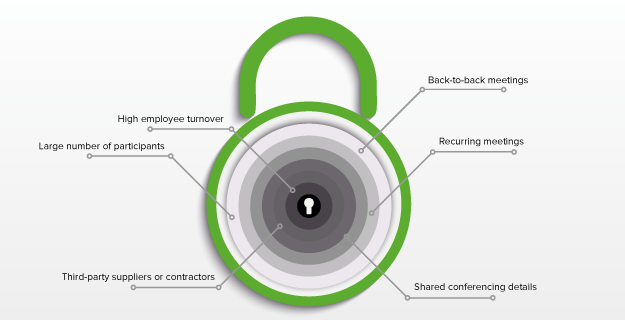
I recently wrote about the why visibility is crucially important for conference call security. Without being able to see a live readout of participants, you can never be sure exactly who’s on the call – and that no-one is there who shouldn’t be. Sensitive information is often shared on conference calls, and so prioritizing conference call security is essential to avoid unnecessary business risk. Here are 6 conference call security risk factors to look out for when you’re assessing your vulnerability. If you recognize that any of these risk factors are present in your conferencing, then you need to find a product that provides visibility.
1. Back-to-back meetings
If you schedule one meeting immediately after another on the same conference facility, there is a chance that at some point you will have participants on the call who shouldn’t be there. This could be because meeting number one runs long, or participants invited to meeting number two may join early. Without visibility of your conference calls, this has the potential to be chaotic as you hear ‘badoops’ signaling unknown people joining and leaving. Worse than this, though, is the security implication of not knowing who’s on your call.
2. Recurring meetings
If you host recurring meetings, anyone with those dial-in details and knowledge of the time of the meeting will be able to join – even if they are no longer supposed to be involved. Visibility ensures you know who’s on, and can tell if unwanted participants are on the line.
3. Shared conferencing details
When an individual does not have their own conference details, they do not have control over when these details are used. Teams sharing a set of codes run the risk of accidentally scheduling conference calls at the same time. This can lead to two sets of participants joining at once or participants invited to one user’s call turning up on the line uninvited. The wider one set of dial-in details is distributed, the higher the chance of people turning up to calls they’re not invited to. Visibility is essential to be able to identify who is on the call at all times.
4. Third-party suppliers or contractors
Contingent workers or third-party personnel who spend a short time in your business may well still get access to sensitive details like conference codes. As with high employee turnover, recurring use of the same codes compounds this problem. Pair this with back-to-back meetings and reusing your line and, if you don’t have visibility, the problem multiplies.
5. High employee turnover
Organizations with high employee turnover by default have a higher conference call security risk. When employees leave, they may well keep hold of the participant conference call details for calls they attended. If codes aren’t changed, these calls are open indefinitely to eavesdropping from former employees. The most damaging example of this is likely to be the salesperson who moves to a competitor, but could in theory continue to listen into and gain information on the former employee’s customers and pipeline with poaching in mind. Visibility lets the call leader know who’s on the line – when combined with suitable call controls, the leader can isolate the line of anyone unfamiliar, and drop them from the call if needed.
6. Large number of participants
Of course, more participants invited to a call means more people with access to the codes and the ability to use them in future. More pertinently, though, if the call host is relying on the badoops signaling participants joining and leaving, it will be extremely hard to keep track, meaning that any unwanted participants may pass unnoticed – and can lead to that conferencing classic “who just left?” Visibility lets the call leader see whom these ‘badoops’ relate to.
If you identify with several of these risk factors – and you don’t have visibility on your calls – then you are at risk of unwanted participants listening in, whether as an innocent mistake or something more sinister. As a matter of priority, investigate providers who do offer this level of visibility, but be sure that the visibility is presented in an easy-to-use way, so that you will reap the benefits of this crucial piece of information.
Read more:









